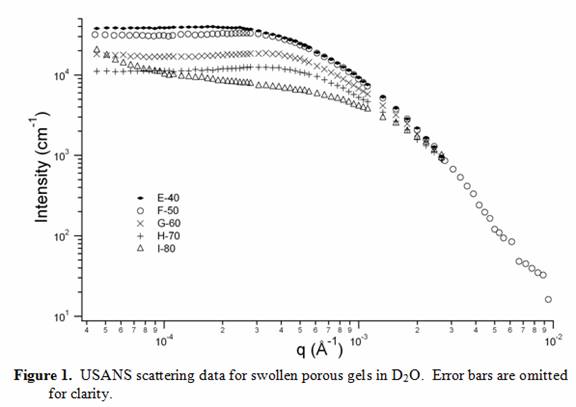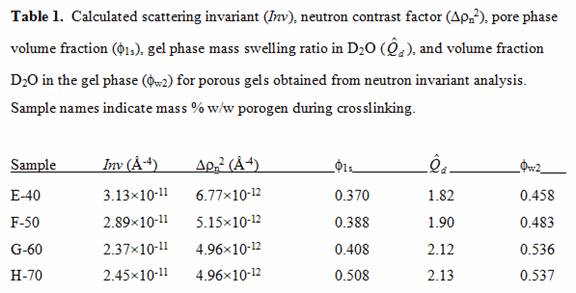AmericanChemicalSociety.com
Reports: ND7 48944-ND7: Non-Affine Swelling and Swelling Kinetics of Microporous Polyelectrolyte Gels
Ronald C. Hedden, PhD, Texas Tech University
Hydrogels are water-swollen polymer networks that have been widely studied as biomedical, biomimetic, super-absorbent, and stimuli-responsive materials. Porosity can be engineered into hydrogels to achieve rapid changes in the macroscopic volume swelling ratio in response to environmental conditions, to control the rate of release of a drug or other chemical agent, or to mimic the structure and/or mass transfer characteristics of living tissue. Micrometer-scale porosity has been engineered into both ionic and non-ionic gels by leaching of a porogen after crosslinking or by other methods. Porosity can facilitate ultra-fast swelling response upon immersion in good solvents or in response to temperature. In stimuli-responsive gels, the presence of porosity decreases the response time, allowing shrinkage or swelling of the material in as little as a few seconds. Porous hydrogels are an important class of soft materials that will continue to receive attention due to their fascinating physics and because of emerging applications.
Optimizing the swelling kinetics, mechanical behavior, and stimuli-responsive properties of porous gels requires experimental methods for characterization of both pore volume fraction and gel-phase water content. Due to the possibility that the pore phase volume fraction may change during swelling, it is usually not possible to assume affine changes in the dimensions of the voids upon swelling/deswelling. A suitable theoretical framework relating pore volume fraction to the equilibrium volume swelling ratio is needed. Experimental methods are needed to calculate both water concentration within the gel phase and the volume fraction of porosity in the swollen state, motivating our study.
The first year of our grant produced new knowledge regarding the swelling behavior of porous, sponge-like polymer hydrogels made of the slightly hydrophilic polymer poly(hydroxyethylmethacrylate), or poly(HEMA). We prepared and characterized poly(HEMA) gels that contain a high volume fraction (0.3 to 0.5) of micrometer-scale pores when swollen with water. Gels were crosslinked in the presence of 40 to 80 % w/w of an extractable, polymeric porogen. After removal of the porogen by soaking in water, the porous gels appeared strongly opaque due to the numerous pores, but they became transparent upon drying due to shrinkage or disappearance of the pore phase. These interesting materials served as models for our work on characterization techniques for determining pore volume fraction and water content in porous gels.
Ultra small-angle neutron scattering (USANS) and equilibrium swelling measurements were combined to characterize correlation length, pore volume fraction, and gel-phase water content in the porous poly(HEMA) gels. USANS experiments were conducted at the NIST Center for Neutron Research using the BT5 Perfect Crystal Diffractometer.1 Fig. 1 shows USANS data for a series of water-swollen gels that had different mass fractions of porogen (mass % porogen indicated by sample name). The porogen had already been extracted in each case, and water was replaced by D2O to increase neutron contrast. The USANS technique differs from ordinary SANS in that it can probe scattering from structures as large as several tens of micrometers, due to the extremely low q values accessible.
An analytical model was developed
which relates the scattering invariant to chemical composition, swelling
behavior, and structural parameters. The
correlation length associated with porosity was measured by fitting USANS data
to an appropriate scattering model, such as the Teubner-Strey model. By combining swelling measurements with USANS
invariant analysis, it was possible to determine the equilibrium volume
fraction of pores and the concentration of water in the gel phase (Table 1). These important parameters are not accessible
to imaging techniques commonly used in materials characterization, such as electron
microscopy. USANS measurements also
confirmed that the pore phase essentially disappeared after slow drying of the
gels in air. The USANS technique is a versatile,
non-invasive method to characterize pore size, volume fraction, and water
content in soft materials.
The new USANS methods represent a
useful advance in soft materials characterization, as the analytical methods we
developed can be applied to characterize swelling behavior of many types of
porous soft materials, including biological materials and superabsorbent synthetic
polymers. In addition, we have gained
new insights regarding the swelling of porous polymer gels, namely, that the
pore size and volume fraction can be expected to vary strongly with the degree
of swelling. Future work during the
remainder of the grant period will address two additional questions regarding
the swelling of porous hydrogels: how does solvent quality affect pore size and
volume fraction, and how does mechanical compression affect pore size and
volume fraction? Approaching these key
questions with our newly developed analytical tools will provide new insights
regarding the influence of porosity on equilibrium swelling and rheological
behavior of porous gels.
1We acknowledge the support of the National
Institute of Standards and 
Copyright © American Chemical Society


